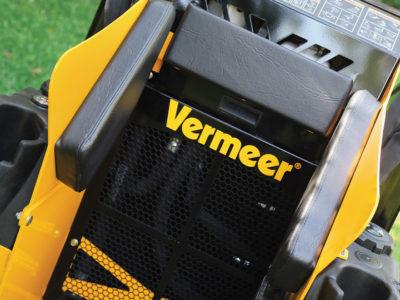Picture this: You’ve got a lot of work staring you down, and the forecast for the next two weeks is rain. It looks like you and the crew will have to put in long days to get the work done on time, which means more time behind the controls of your mini skid steer (sometimes referred to as a compact utility loader or a compact tool carrier). In situations like this, it helps to have a model with controls designed for professional operators who spend several hours each day running equipment.
You probably face scenarios like this almost every week of the year; and while mini skids steers help you get the job done, not all are designed for operator comfort.
“Often contractors will spend more than 8 hours a day, 5 to 7 days a week, running a mini skid steer using a variety of attachments,” explained Trevor Koolmees, sales manager for Vermeer Tree Care, Rental, and Landscape equipment. “That’s the type of individual we design equipment for. The functionality of the mini skid steer controls and the comfort of the operator station is important to their overall productivity. We want operators fresh and looking forward to a productive day’s work, instead of feeling the aches and pains from the previous day. Often that comes down to small details that most people don’t think about.”
Optimizing mini skid steer controls
Small details make Vermeer mini skid steer controls more efficient for all-day operation. Koolmees said Vermeer started with an ISO-pattern joystick. “This joystick isn’t necessarily unique to Vermeer, and that’s a good thing. ISO joysticks are used in a lot of construction equipment to control movement. That means operators that run larger skid steer loaders, wheel loaders or even dozers can quickly familiarize themselves the Vermeer mini skid steer controls,” he explained.
While not every manufacturer in the compact utility loader category uses ISO pattern controls, contractors prefer it because the pattern is intuitive, and the joystick fits well in the operator’s hand.
A left-hand joystick controls movement on Vermeer mini skid steers. A handgrip bar provides a comfortable resting point for the palm and wrist during operations.
Controls for the loader arms and attachment hydraulics are on the right side. Like the left-side control, those on the right also have a handgrip bar. The main joystick raises and lowers the loader arms, and curls and tilts the attachment plate. Two additional levers optimize hydraulic attachment performance.
“How mini skid steers engage and disengage hydraulics varies,” said Koolmees. “Some machines may have various push buttons and toggle switches, which aren’t very intuitive during normal operations. Other loaders require operators to push a separate button with their foot. Working in uneven terrain, or even having mud on the operator’s boots, can sometimes result in button pushes with this design.”
The auxiliary hydraulic controls on Vermeer mini skid steers have two hydraulic levers. You can engage the high-flow lever (equipped on machines with dual auxiliary hydraulics) by pushing it forward or pulling it back, and then returning to the center to shut off the flow to the attachment. Vermeer designed this hydraulic lever for attachments requiring constant hydraulic flow, like trenchers and augers.
The other hydraulic (low-flow) lever is meant for attachments that require flow only when performing a specific task, like opening and closing the tongs on a grapple bucket. This lever is positioned just above the loader’s arm controls and can be operated together using the same hand.
Vermeer mini skid steers also have a throttle leveler to control engine speed.
“Joysticks and controls instead of push buttons and control bars may not seem that different, but for someone who may spend most days running a machine, it can help them work more efficiently,” said Koolmees. “Operators can feel where the controls are instead of looking down at the control station to push a button. And it gives them a better feel of machine movements, and more control to throttle down when an application calls for it. Those are small details, but they make a difference to professional operators.”
Operator platform design
Designing mini skid steer controls for professionals extends beyond the control station. The operator’s platform is another detail that impacts an operator’s performance. Some compact utility loaders have a platform that extends off the back of the machine, almost like an add-on. Vermeer took a different approach and incorporated a chariot-style ride-on platform with an integrated operator-presence system and padding on three sides. This design helps with operator comfort throughout the day and provides stability when working on uneven terrain.
“Most operators like feeling like they are riding on the machine instead of behind it,” said Koolmees. “The Vermeer platform design gives the operator optimal visibility to the loader arms and attachments and stability because they are actually on the machine instead of standing on a platform behind it. That can maximize ride comfort.”
Built for professionals
Any piece of equipment a contractor will spend hours a day running should have controls designed specifically for their professional needs. Creating mini skid steer controls starts with understanding the needs of professional operators and building a control station specifically for them. That’s what you’ll find when you operate a Vermeer mini skid steer.
Read more about Vermeer mini skid steer models, or contact your local Vermeer dealer to experience the difference in Vermeer mini skid steers for yourself.
Vermeer Corporation reserves the right to make changes in engineering, design and specifications; add improvements; or discontinue manufacturing at any time without notice or obligation. Equipment shown is for illustrative purposes only and may display optional accessories or components specific to their global region. Mini skid steer attachments available from Vermeer dealers may be manufactured by Vermeer Corporation or other attachment manufacturers. Please contact your local Vermeer dealer for more information on machine specifications and attachments.
Vermeer and the Vermeer logo are trademarks of Vermeer Manufacturing Company in the U.S. and/or other countries. © 2022 Vermeer Corporation. All Rights Reserved.
